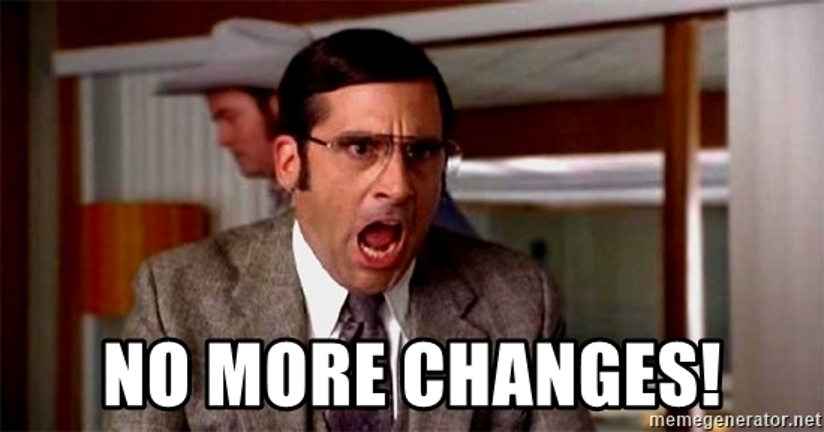
“We have changes.”
These are the words no art director or copywriter wants to hear – doesn’t matter who says them. If we were in the office, you’d hear a large groan and maybe see a few eye rolls. Spoiler alert: Creatives always complain about changes. Just ask any account executive.
You see we’ve been caring for this obviously brilliant idea like it’s one of our own kids. We nurture it to its full potential and then anxiously send it out into the world, hoping it will be loved. And, sometimes we’re so close to the idea that we don’t see why anyone would want to change it. I mean, it’s perfect. Right?
Ok, so maybe I’m poking fun at stereotypes in the ad industry a bit, but it sure seems like, as humans, we are generally uncomfortable with change. When someone suggests zigging instead of zagging our knee-jerk reaction is often “Wait, what? Nooooooo.”

That uneasiness with change can also be felt by businesses who are just trying to navigate and compete for their piece of the market-share pie. The tendency to always lean on what has worked in the past feels comfortable and safe. You know what works, so you keep doing it – until, say, a pandemic comes along and flips everything upside down.
But, pandemic or no pandemic, change is inevitable, so I implore you to embrace it; love it even. Do not dread change, think of it as a chance to do better. Here’s why:
- Change forces you into an innovative posture. Remember when Netflix used to send DVDs to subscribers in the mail? If they would have stayed on the same video rental path as Blockbuster Video, the business surely would have failed. They had the foresight to see how the world was changing in the internet age, so they adapted. They embraced the opportunity for innovation. They have continued to evolve by creating critically acclaimed original content and are currently #1 in digital video streaming in the U.S. (Source)
- Change is not a roadblock, it’s an opportunity. As millions of gym-goers were forced to remain in their homes this year because of COVID-19, Peloton, a live-streaming workout company, saw this as an opportunity for growth. Can’t go to the gym? No problem – Peloton will bring the gym to you. Peloton quickly slashed their monthly subscription prices and their memberships soared. Even when the pandemic hit hard, shutting down most businesses, Peloton instructors pivoted and began teaching live classes from their own homes in order to keep their 3 million users engaged.
- Change can be for the greater good. The Black Lives Matter movement and the tragic death of George Floyd brought to the forefront conversations about racial injustice. Spurred by those conversations, several companies made the long-overdue decision to change their racially insensitive logos and mascots. Brands like Aunt Jemima, Uncle Ben’s, Land O’Lakes, and the NFL team, the Washington Redskins, have committed to addressing and changing their outdated images. While food and sports brands may play a tiny part in bringing a spotlight to this social movement, their visibility is not so tiny. Their visual change and the communication around it allow us, as consumers, to keep talking about the very important “why”.
- Change is inevitable, so learn to be really resilient. When I talk to young people who are interested in advertising/marketing, the question I get asked the most is: how do you not take all the feedback and criticism about your designs personally? It is really hard to think objectively about something you’ve poured your heart and soul into, but chances are what you’ve created isn’t perfect. Instead, choose progress over perfection and be resilient in the face of uncertainty and change. When you come out on the other side of it (and you will), you will have learned something that will help you next time you tackle a problem.
I know I’ve said the word “change” a lot in this blog (16 times to be exact). But it’s because I’d like you to consider being friends with change or, at least acquaintances because it will be no stranger to you or your business plans.



